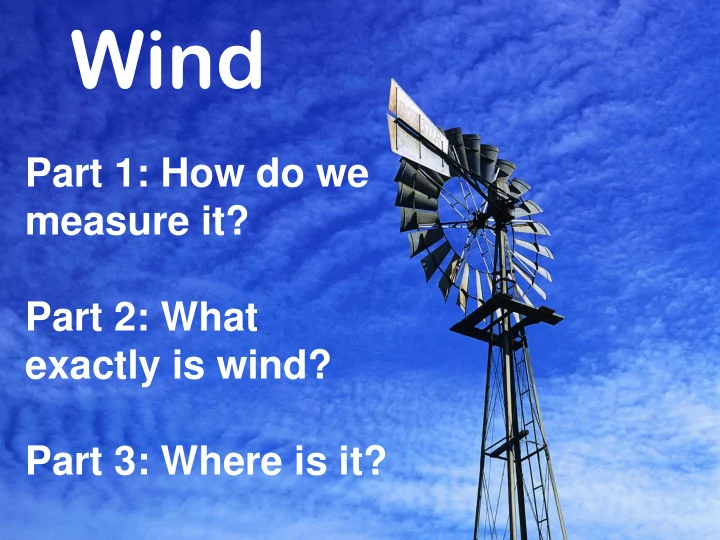

Wind Part 1: How do we measure it? Part 2: What exactly is wind? Part 3: Where is it?
PART 1: • Wind speed = Measuring anemometer Wind • Wind direction = wind vane – given from the direction it came FROM. • Wind chill = increased cooling (wind removes heat from you)
WIND VANE • Points into the wind • Winds are named by where they come FROM • A WESTERLY wind is coming FROM the West.
Which way is the wind blowing TOWARDS? Where is it blowing FROM?
Part 2: What exactly is wind? • air is a “fluid” so it acts like water • It moves from HIGH pressure to LOW pressure. • When air moves it is called wind
Remember what causes wind? • When cold high pressure air is next to hot low pressure air so it moves to equalize HIGH Pressure
Different places on Earth heat differently which makes the wind blow • Wind blows from the poles to the equator • Water can cause winds • Cities/Forests can cause winds
Wind blows from poles to equator Hot air rises at HIGH equator and cold air Pressure sinks at poles High pressure LOW rushes to equalize Pressure Low pressure
Water can cause winds: Heating Earth’s Surface • It takes longer for water to heat up in the day • It takes longer for water to cool off at night too. THIS MAKES WIND
Day: land heats up first and hot air rises Night: land cools off first and cold air sinks Which one is night and which is day?
SEA BREEZE • Hot air rises and cold air sinks causing it to circulate and the wind blows: convection • Day breeze goes inland • Night breeze goes offshore
CITIES & FORESTS can cause winds Hotter = Low pressure Cooler = High pressure
Part 3: Where is all the wind?
WINDS are anywhere a High pressure area is next to a low pressure area
On Earth the winds blow from pole (high P) to equator (low P) • But the Earth spins and it messes everything up!
The Coriolis Effect • If Earth did not rotate, global winds would blow in a straight line from the poles toward the equator. • The way the Earth’s rotation makes winds curve is called the Coriolis Effect . • http://daphne.palomar.edu/pdeen/Animation s/34_Coriolis.swf
Global Winds: large scale winds
Global Convection Currents • What causes global winds? – Convection in the atmosphere – air going towards the equator – coriolis effect
Global Wind Belts • Doldrums • Horse Latitudes • Trade Winds • Westerlies • Polar Easterlies
Recommend
More recommend